Must Have Car Safety Features Guide: Which Ones Are Essential?
November 17, 2021
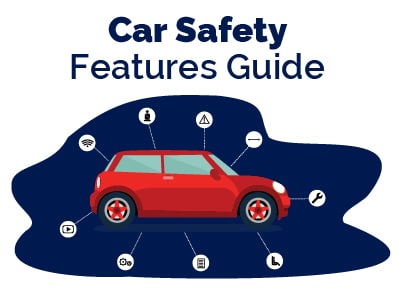

I am a serial entrepreneur and a consumer advocate. When I’m not helping car buyers, I love working on ventures that have a positive impact.
I run a cause marketing agency and serve on the board of Vayu Global Health where we are disrupting the medical industry and preventing the needless deaths of mothers and babies during childbirth.
For a long time, the main safety features in cars were things like seatbelts and front airbags. However, cars and technology have come a long way. There are now many different safety features to choose from.
Which modern safety features are the most important and which are just nice to have?
Read on for our full car safety features breakdown and which ones we consider as must-haves.
Check out our picks for the safest new & used vehicles available today >>
Table of Contents
Top Car Safety Features Breakdown
| Safety Feature | Our Recommendation |
| Automatic Emergency Braking | Must-Have |
| Blind Spot Monitoring | Must-Have |
| Adaptive Cruise Control | Must-Have |
| Lane Departure Warning | Must-Have |
| Traction Control | Must-Have |
| Anti-Lock Braking System (ABS) | Must-Have |
| Backup Camera | Must-Have |
| Forward Collision Warning | Highly Recommended |
| Parking Sensors | Highly Recommended |
| Lane Keeping Assist | Highly Recommended |
| Brake Assist | Highly Recommended |
| Electronic Stability Control | Highly Recommended |
| Adaptive Headlights | Highly Recommended |
| Driver Attention Monitor | Highly Recommended |
| Rear Cross-Traffic Alert | Recommended |
| Rear Automatic Emergency Braking | Recommended |
| Hill Descent/Start Assist | Recommended |
| Pedestrian and Cyclist Detection | Nice to Have |
| Semi-Autonomous Driving | Nice to Have |
| Active Park Assist | Nice to Have |
| Automatic High Beams | Nice to Have |
| Traffic Sign Recognition | Nice to Have |
Types of Safety Features in a Car
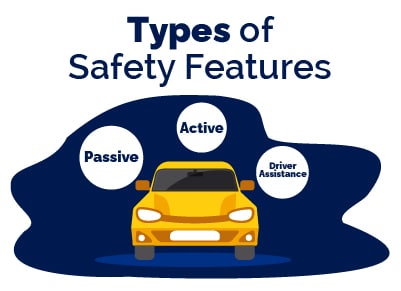 What Are Active Safety Features?
What Are Active Safety Features?
Active safety features continuously work as you drive to prevent accidents. Typically, a computer controls these electronic features. Some examples of active safety features include lane departure alerts, blind-spot monitoring, and traction control.
What Are Driver Assistance Features?
Driver assistance features are meant to make driving less stressful and safer. Interestingly, many drivers don’t realize they have these features. Because of this, they are often left off. A few examples are automatic emergency braking, adaptive cruise control, and traffic sign recognition. This can be especially useful for short drivers with low visibility and seniors.
What Are Passive Safety Features?
Passive features only work when called into action. For example, when an accident takes place, the passive safety features activate to minimize injury and damage. Common examples of passive safety features include airbags and seat belts.
Best Car Safety Features
Safety features in vehicles have made huge advancements in recent years. There is now a wealth of standard, must-have safety features. For 2022, here are some of the top safety features to consider:
- Blind-spot monitoring
- Traction control
- Automatic emergency braking system
- Antilock braking system
- Backup cameras
- Lane-keeping assistance
We’ll dive more into each of these features in the next section.
Most Popular Safety Features Explained
Here are some of the most popular safety features available right now.
Collision Warning and Prevention
Forward Collision Warning
This system tells a driver when they are getting too close to the car in front of them. Some vehicles with forward-collision warnings include automatic brake pressure to minimize the damage of a crash.
Our Recommendation: Highly Recommended
This is a simple, yet powerful feature that can help drivers avoid some of the most common collisions.
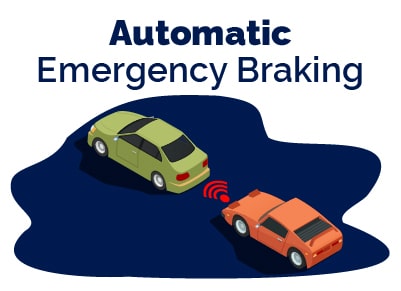 Automatic Emergency Braking
Automatic Emergency Braking
Automatic emergency braking follows a forward collision warning. If the system perceives a potential collision and you do not react quick enough, the car automatically brakes.
Our Recommendation: Must-Have
Automatic emergency braking will engage if the vehicle detects an imminent collision. We cannot always react quick enough, and this feature can help prevent common fender benders.
Pedestrian and Cyclist Detection
This system relies on the forward collision warning and automatic braking system to help protect cyclists and pedestrians. The vehicle’s camera looks for any pedestrians in the path. Some will warn drivers, and the system may automatically brake if the risk of collision is high.
Our Recommendation: Nice to Have
Of course, this is a great feature that can help drivers safely navigate pedestrian-heavy areas. In reality, how useful this feature depends on your typical driving areas. If you live in a foot-traffic-heavy area, it may be more valuable than if you live/drive in other environments.
Rear Cross-Traffic Alert
This system assesses the likelihood of traffic crossing your path when you reverse. It’s very helpful when backing out of a driveway or parking spot. Many systems include automatic emergency braking to avoid a collision.
Our Recommendation: Recommended
When backing up, it can be difficult to account for traffic crossing your path, especially if the traffic is not paying attention to you as well. Rear-cross traffic alert helps you safely back up, avoiding oncoming traffic. It’s something we recommend, but some other features (like a backup camera) mean it’s not absolutely mandatory.
Rear Automatic Emergency Braking
Many rear cross-traffic alert systems include automatic emergency braking. The car automatically brakes if it senses cross-traffic as you’re backing up.
Our Recommendation: Recommended
If you do opt for rear-traffic control, then you should definitely consider one with automatic emergency braking. It takes that system a step further, stopping your vehicle if it senses oncoming cross-traffic.
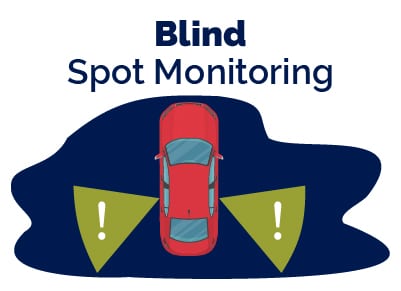 Blind Spot Monitoring
Blind Spot Monitoring
Blind-spot monitoring is typically located on the side mirrors. It detects objects that are in your blind spot and will alert you if there is something there. Sometimes, blind-spot monitoring may beep if you try to switch lanes while something is in your blind spot.
Our recommendation: Must-Have
The blind spot is an incredibly dangerous aspect of driving, especially on highways. Blind-spot monitoring can help you safely change lanes and ensure you don’t miss anything. It’s now a common feature and is a must-have in our book.
Parking Sensors
Parking sensors warn you when you are too close to an object during parking. They are usually ultrasonic sensors on the front and rear bumper. Some newer vehicles may also include a camera along with the sensors.
Our Recommendation: Highly Recommended
Parking sensors are highly recommended because they help avoid bumps, collisions, and other issues during parking. They ensure a smooth parking experience and can be incredibly helpful for those who park in tight spaces.
Driving Control Assistance
Adaptive Cruise Control
The adaptive cruise control maintains a safe, consistent distance between you and the car ahead. It relies on lasers, cameras, and/or radar to automatically brake if traffic slows. It will automatically increase your speed when traffic flows again as well.
Our Recommendation: Must-Have
Adaptive cruise control has been a common safety feature for many years, and it’s still a must-have. It’s especially helpful for longer drives and is much safer than non-adaptive cruise control since it adjusts to traffic.
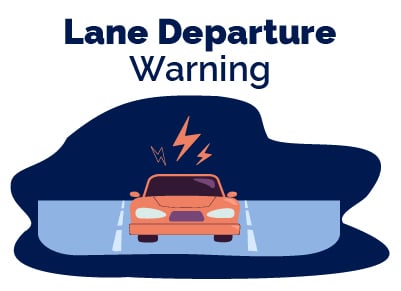 Lane Departure Warning
Lane Departure Warning
This system monitors the position of the vehicle within the lane. If the vehicle comes too close to the lines or crosses the lane markers, it will alert the driver.
Our Recommendation: Must-Have
This feature helps keep drivers in their lane, which is imperative for avoiding collisions. It can help distracted or tired drivers stay on track. We view this as a must-have modern safety feature.
Lane Keeping Assist
Lane-keeping assist technology adjusts your steering wheel mildly to keep you in your lane.
Our Recommendation: Highly Recommended
Lane-keeping assist is the next step up from lane departure warning. We still highly recommend it, as it automatically keeps you in your lane.
Semi-Autonomous Driving
Semi-autonomous driving is a level of self-driving that includes automatic acceleration, acceleration, and stopping without human action. This system may be able to keep a vehicle in its lane, but it doesn’t include parking.
Our Recommendation: Nice to Have
Semi-autonomous driving combines several features to automate many aspects of driving. This is certainly nice to have, but not a crucial one.
Active Park Assist
Active park assist will steer your vehicle into parking spaces. You can turn it on with a button, then it automatically locates a suitable parking space and parks your car in it.
Our Recommendation: Nice to Have
Active park assist is also nice to have. It certainly adds convenience and will save you time, but it’s not a crucial safety feature for parking.
Hill Descent/Start Assist
This feature helps prevent the vehicle from slipping down a hill when you begin motion on an incline.
Our Recommendation: Recommended
How important this feature is also depends on your environment. Those who live in very hilly areas may find it more imperative than those who rarely face hills.
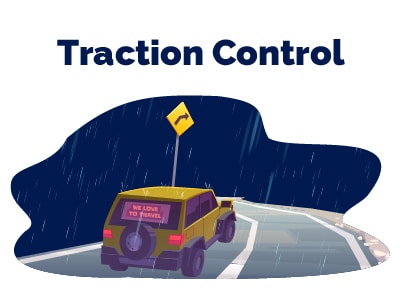 Traction Control
Traction Control
Traction control limits wheel-spinning during acceleration. The purpose of this is to ensure optimal traction. It’s especially helpful in slippery, icy conditions or with a high-horsepower engine.
Our Recommendation: Must-Have
Traction control is absolutely essential as a safety feature. Even those who do not live in snowy climates may face unexpected, slippery conditions.
Brake Assist
Brake assist is meant to help in situations when the driver slams on the brakes (vs normal braking). The system detects a panic stop and will apply the maximum braking force. It leverages anti-lock braking to brake as hard as possible without locking. This helps drivers stop in the shortest distance possible.
Our Recommendation: Highly Recommended
Brake assist is another key feature that can help prevent serious accidents. We highly recommend this feature for that reason.
 Anti-Lock Braking System (ABS)
Anti-Lock Braking System (ABS)
Hard, sudden braking can lock the braking system. An anti-lock braking system prevents locking with the help of sensors at each wheel. A computer improves the braking level for each wheel to help reduce the chances of a lock-up.
Our Recommendation: Must-Have
Anti-lock brakes are extremely common, and now a must-have feature. Locked brakes are a serious hazard, and this system helps prevent them.
Electronic Stability Control
Electronic stability control is a step up from traction control. It helps prevent the vehicle from going off course and skidding or sliding. ESC relies on computers linked to sensors that assess wheel speed and angle along with vehicle rotation and sideways motion. The system temporarily applies brakes to one or more wheels if the vehicle goes outside of the intended path.
Our Recommendation: Highly Recommended
While traction control is a must-have, this step up from traction control is still highly recommended. It’s especially important if you live in a climate with snow and ice.
Vision and Headlights
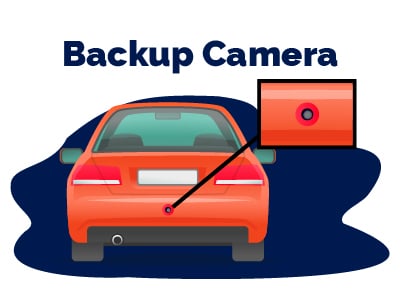 Backup Camera
Backup Camera
Placing your vehicle in reverse activates the backup camera. The backup camera displays a view on your screen or rear-view mirror. It provides a bumper-level view, which can help with backing up, especially in or out of a parking spot. Many backup cameras include parking guidelines that help you ensure you park straight and within the lines of the spot.
Our Recommendation: Must-Have
Backup cameras are simple, yet provide key visibility for safely reversing. This feature also reduces the need for some of the other reverse features, which is why it’s a must-have.
Adaptive Headlights
Adaptive headlights are able to adjust their position based on the car’s direction. They are not in a fixed position and will adjust their angle and swivel based on the direction of your vehicle to ensure maximum visibility.
Our Recommendation: Highly Recommended
Adaptive headlights ensure greater visibility, but they aren’t critical for night driving. We highly recommend considering them.
Automatic High Beams
Automatic high beams adjust to and from low to high on their own. This helps with nighttime visibility. It also helps to avoid blinding oncoming drivers, for all-around safer nighttime driving.
Our Recommendation: Nice to Have
Automatic high beams provide you with convenience while also helping nighttime driving. However, they are not critical.
Traffic Sign Recognition
This system uses a front camera to scan the road for traffic signs. The character recognition software notes any changes that are needed based on the sign. The car displays the information until the necessary changes are made.
Our Recommendation: Nice to Have
Traffic sign recognition will help you ensure you don’t miss important traffic information. Still, it’s more of a convenience than a must-have.
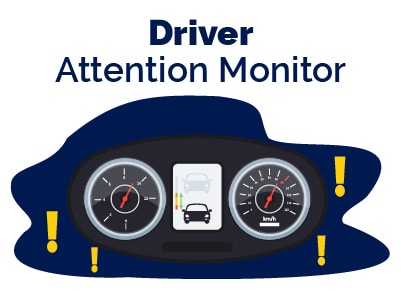 Driver Attention Monitor
Driver Attention Monitor
Driver attention monitor assesses the steering pattern, vehicle position, and more to determine if a driver is losing attention. If the system detects a lack of attention, it alerts the driver.
Our Recommendation: Highly Recommended
This system can help tired or distracted drivers get back on track. It can also serve as a warning that you need a break. We find it most important for those who have long drives or do a lot of night driving.
Best Car Deals by Category
Frequently Asked Questions
What are the main safety features in a car?
Standard safety features include electronic stability control, seat belts, anti-lock brakes, front airbags, and side curtain airbags. Many newer cars also include features like backup cameras, adaptive cruise control, and traction control.
What's the difference between active and passive safety features?
Active safety features work automatically to help prevent accidents. An example of an active safety feature is blind-spot monitoring. Passive features are only active in the event of a collision. An example of a passive safety feature is airbags.
What car model has the most standard safety features?
There are now many vehicles that include an abundance of standards safety features. One of the vehicles most highly rated for safety is the Subaru Legacy, which includes adaptive headlights, EyeSight Driver Assist, Lane-Keeping Assist, Active Cruise Control, and more.
Which company makes the safest cars?
Volvo and Hyundai (especially the Genesis luxury division of Hyundai) are rated as two of the car companies that make the safest vehicles.
What are the latest and newest safety features?
As technology becomes more advanced, new safety features are added to vehicles. Some of the latest safety features include lane-keeping assist, safe exit warnings, blind-spot video feeds, 360-degree/overhead cameras, and backup cameras with parking assistance.
Can you add safety features to a car?
Yes, most often you can add safety features to your vehicle. Many manufacturers offer newer, more advanced safety features as upgrades/add ons. Furthermore, there are many aftermarket safety systems that you can install as well.
Posted in Car Buying Tips |




